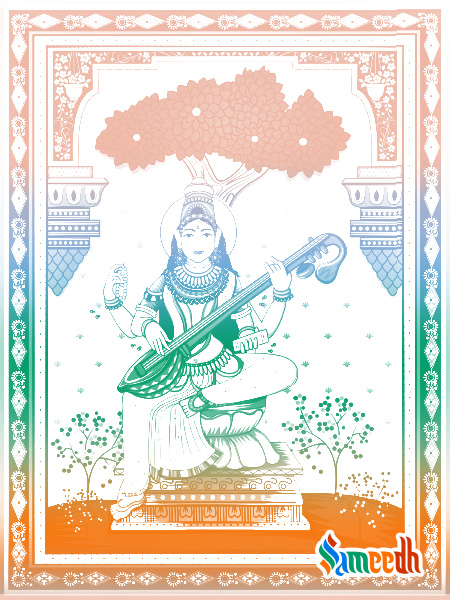The supreme Hindu goddess of knowledge, speech and music.

Saraswati is the Hindu goddess of knowledge, arts, music, education, speech and learning. Saraswati means a couple of things including flow, speech, woman and water. Which results in the existence of an Indian river by the same name. She along with goddesses Lakshmi and Parvati, form the Tridevi, 3 female deities.
Vasant Panchami
Vasant Panchami, the fifth day of the Spring season is celebrated in her honour and is also known as Saraswati Puja or worship of Saraswati. On this auspicious day, children are taught to read and write, commencing their learning journey. Books and pens are distributed too while the festival is rejoiced with music and food. Students are known to widely worship Saraswati for their academic excellence, insight and creativity for musical forms of arts.
Origins
It is believed that Brahma created Saraswati from his mouth, making her the ultimate goddess of speech. It was when chaos started churning amidst mortals, Brahma decided to establish order through knowledge. Knowledge combined with arts would give beings purpose, expand their minds to possibilities, the urge to discover, achieve to find enlightenment, peace and happiness.
Although Sarawasti arose from Brahma, the latter found himself infatuated with her. The goddess tried avoiding the god of creation but in vain, He followed her through all four cardinal directions, growing a head in one of those sides. She even tried going above his head to lose him, but a fifth head popped up above all others. His enraged Shiva, the god of destruction, due to its incestuous nature and he cut off Brahma’s fifth head. Shatrupa is the name associated with the multiple forms which Saraswati transformed into to curb Brahma’s desires. The term Brahmani is attributed to her for sharing the powers of Brahma.
Physical Form
Goddess Saraswati wears a white saree, a woman’s garment in India, which symbolises purity and light. She hardly adorns any jewels as her energy stems from knowledge and she chooses that over worldly, materialistic things. Her representation of knowledge and pureness extends to her vehicle or vahan, of a white swan and the bloomed lotus on which she is seated. The swan, her ride, possesses the ability to only drink milk from a mixture of both milk and water, demonstrating its capacity to discriminate against evil from good. The colour yellow in the mustard shade is associated with her as it is the colour of flowers that blossom during Spring. She is depicted with four hands carrying and playing Veena, a musical instrument, a string of rosary beads known as Rudhraksh, a book, symbolising knowledge and a pot of water which helps retain purity. Her four hands are a reflection of her consort, Brahma and signify Manas – mind and senses, Buddhi – intellect, Citta – Imagination, creativity and Ahamkar – ego and consciousness. It also illustrates the 4 sacred Vedas, religious Hindu scripture. These Vedas are known to be the offsprings of Saraswati and Brahma. This goddess of eternal wisdom is known to give birth to Sanskrit too, one of the oldest languages in the world. She personifies the sattva guna or quality of honesty, calm, goodwill and harmony.
Saraswati, the divine epitome of wisdom has many followers seeking out for educational betterment and progress, overall success in life through knowledge, a peaceful and enlightened state of mind, be it through the river or the goddess herself.
